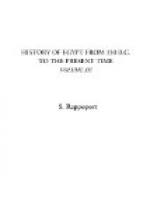As the earth revolves from west to east, the waters of the Nile tend to be driven upon the right bank on the west, where the current is constantly eating away the sandstone and limestone cliffs. For this reason the left side of the river is far more fertile and well cultivated than the right bank. Below Ombos the valley is narrowly constructed, being but thirteen hundred yards in width, the cliffs overhanging the river on either side, but at Thebes it broadens out to nine or ten miles, and farther up, in the Keneh district, the valley is twelve or fifteen miles in width. The river here approaches within sixty miles of the Red Sea, and it is believed that a branch of the Nile once flowed out into the sea in this direction.
[Illustration: 237.jpg THE PLAIN OF THEBES]
Seventy miles below Keneh the Nile throws from its left bank the Bahr Yusef branch, a small current of 350 feet in breadth, which flows for hundreds of miles through the broader strip of alluvial land between the main stream and the Libyan escarpments. In the Beni-Suef district this stream again bifurcates, the chief branch continuing to wind along the Nile Valley to a point above the Delta, where it joins the main stream. The left branch penetrates westward through a gap in the Libyan escarpments into the Fayum depression, ramifying into a thousand irrigating rills, and pouring its overflow into the Birket-el-Qarum, or “Lake of Horns,” which still floods the lowest cavity and is a remnant of the famous ancient Lake Moris. The Fayum, which is the territory reclaimed from the former lake, is now an exceedingly productive district, a sort of inland delta, fed like the marine delta by the fertilising flood-waters of the Nile.
The traveller Junker wrote of this district in 1875: “I found myself surrounded by a garden tract of unsurpassed fertility, where there was scarcely room for a path amid the exuberant growths; where pedestrians, riders, and animals had to move about along the embankments of countless canals. Now a land of roses, of the vine, olive, sugar-cane, and cotton, where the orange and lemon plants attain the size of our apple-trees, it was in primeval times an arid depression of the stony and sandy Libyan waste.”
North of the Fayum the Nile flows on to Cairo, where the narrow water way allowed to its course by the two lines of cliffs widens, and the cliffs recede to the right and left. There is thus space for the waters to spread and ramify over the alluvial plain. Nearly all this portion of Egypt has been covered by the sediment of the Nile, and from the earliest times there have been numerous distinct branches or channels of the river running out by separate openings into the sea. As several of these branches have been tapped to a great extent for irrigation, all except two have ceased to be true outlets of the Nile. In the Greek period there were seven mouths and several [...Greek...], or “false mouths.” The two remaining mouths are those of Rosetta and Damietta, and these were always the most important of the number. They branched off formerly close to the present spot where Cairo stands, a little below Memphis; but during two thousand years the fork has gradually shifted to about thirteen miles lower down.




